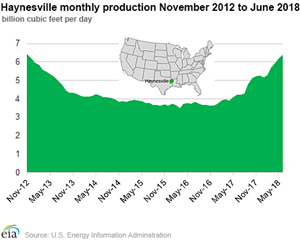EIA: Haynesville natural gas production reaches five-year high
WASHINGTON, D.C. -- In June 2018, natural gas production in the Haynesville shale formation, located in northeastern Texas and Louisiana, averaged 6.35 Bcfd, accounting for 8.5% of the total U.S. dry natural gas production, Haynesville’s highest production level since November 2012.
The Haynesville formation lies deep underground between 10,500 ft and 13,500 ft. In comparison, the depth of the Marcellus shale ranges between 4,000 ft and 8,500 ft. This depth makes drilling costs in the Haynesville shale generally higher than other shale plays. However, breakeven costs have decreased in recent years, making Haynesville natural gas economic at its current prices.
During 2013, when Henry Hub prices averaged $3.80/MMBtu, an average of 45 rigs operated in the Haynesville, which was the second-largest producing shale gas basin after the Marcellus. The rig count increased to 51 rigs in 2014 as Henry Hub prices increased to $4.87/MMBtu. However, when the number of rigs decreased as the Henry Hub price declined, Haynesville reached a low of 20 rigs in operation in 2016. Since then, the Haynesville rig count has steadily increased as Henry Hub prices have remained at or near $3.00/MMBtu.
Dry natural gas production in the Haynesville formation in June 2018 was 23% higher than the production level in June 2013—a new five-year high. In addition to the higher rig count, improvements in well productivity has occurred. Both the average lateral length and initial productivity (IP) rates per well in the Haynesville increased between 2013 and 2017. Lateral lengths have increased steadily from 4,603 ft to 6,421 ft, according to DrillingInfo, while the initial three-month cumulative production per well increased from 496 MMcf in 2013 to 1,176 MMcf in 2017. Productivity gains are expected to continue as producers optimize natural gas recovery from the Haynesville formation.



